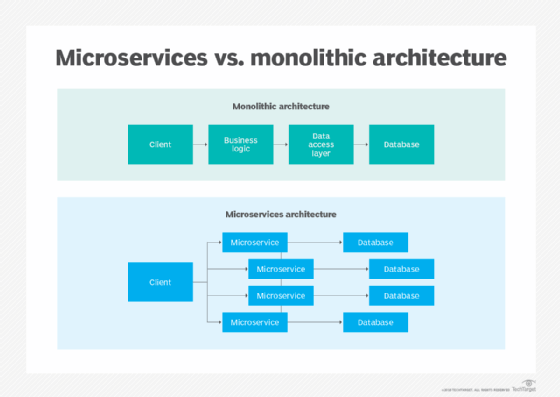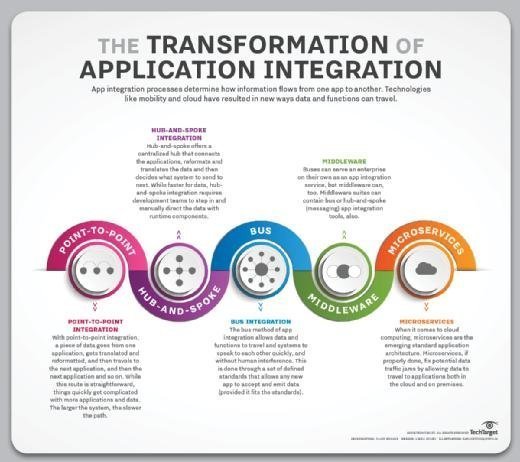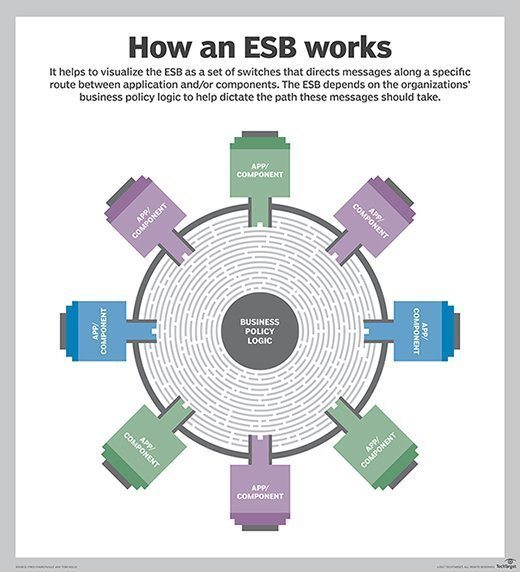EAI (enterprise application integration)
What is enterprise application integration (EAI)?
Enterprise application integration (EAI) is the process of connecting an organization's business applications, services, databases and other systems into an integrating framework that facilitates communications and interoperability. An EAI platform enables the seamless exchange of data, while automating business processes and workflows. The platform ensures that the organization uses its data consistently and that changes to data by one system are correctly reflected in the other systems.
An EAI platform operates like a type of middleware that connects the disparate systems together. The platform can be implemented without reprogramming the participating systems or altering them in any significant way. Instead, the platform uses technologies such as message-oriented middleware (MOM), service-oriented architecture (SOA), enterprise service bus (ESB) or application programming interfaces (APIs) to enable the systems to work together.
An effective EAI platform can accommodate a wide range of on-premises applications and cloud-based services. For example, EAI can be used for systems such as accounting and billing, customer relationship management (CRM), human capital management (HCM), supply chain management (SCM), enterprise resource planning (ERP) and many others. The platform's flexibility also makes it easy to add, remove or update applications or services without impacting productivity or requiring large-scale system redesigns.
Why is enterprise application integration important?
Most organizations rely on numerous applications and services in their day-to-day operations. In addition to serving different purposes, these systems often have their own data stores, proprietary processes and methods of communication. Such disparate systems can create multiple data silos, resulting in duplicate and inconsistent data or data being available to one system but not another.
Siloed data can present a number of challenges. For example, users might need to manually copy and paste data between applications to accomplish a single task or be required to consult multiple applications to carry out their daily routines. At the same time, data analysts must contend with incomplete, inconsistent or inaccurate data, making it difficult to answer important business question or make data-driven decisions.
An EAI platform includes the tools and capabilities necessary to enable the applications and services to share their data and workflows, which in turn can help reduce manual steps, limit the number of data errors, and lead to better insights into the organization's data. System integration becomes even more important as data volumes continue to grow and applications become more sophisticated. In such an environment, an effective EAI platform can offer an organization several important benefits:
- Reduced data silos. By integrating data across systems, an EAI platform reduces or eliminates data silos. The data is accessible by all systems and users, who now have a unified view of the data no matter what tasks they're trying to perform.
- Improved data quality. Data that is integrated through an EAI platform is more accurate and consistent. This improves data quality and makes it easier to understand, share and collaborate on the data. The improved data quality also leads to better analytics and more effective decision-making.
- Streamlined operations. An EAI platform can integrate an organization's key applications and services, resulting in greater operational efficiency and more streamlined business processes. To this end, the platform simplifies workflows, while reducing the time and effort it takes to carry out tasks.
- Improved customer experience. An EAI platform provides a unified view of the data that is accurate, consistent and up to date. The organization's personnel, as well as its customers, have the information they need when they need it, helping to streamline and expedite processes such as sales inquiries, support calls, customer resource management, self-service account updates and other tasks.
- Reduced costs. Because an EAI platform streamlines operations, business processes are more efficient and employees are more productive, both of which can help reduce overall costs. The increased productivity can also lead to new revenue sources because employees have more time to focus on new initiatives. In addition, the ability to integrate legacy systems into the platform can help reduce IT expenditures.

An EAI framework can offer other benefits as well. However, implementing such a platform can also bring with it challenges:
- Complexity. Applications, services and database systems often vary substantially. Not only can the underlying technologies differ, but also the way in which data is stored, formatted, delivered and presented. Trying to integrate these systems into a unified operation is no small task. It takes time, resources and a fair amount of expertise.
- Legacy systems. Integrating legacy systems with other applications and services can be difficult. Older systems are often incompatible with modern applications or even other legacy systems. The older the legacy systems and greater their number, the more challenges they present.
- Scalability. Even if all the applications and services can be seamlessly integrated with each other, an EAI platform might still run into problems as data volumes grow and the number of transactions increases. If an organization relies primarily on cloud services, scalability is usually not much of an issue (except in terms of costs). For on-premises systems, however, an EAI platform must be agile enough to accommodate changes in workload and data patterns, otherwise the EAI platform might suffer serious performance degradation.
- Security risks. When implementing an EAI platform, an organization must ensure that the platform includes effective security and privacy protections and adheres to all applicable regulations. Failing to exercise due diligence in any aspect of the platform's implementation can leave serious holes in those protections. As an EAI platform becomes more complex, so too can security and privacy management.
Goals of enterprise application integration
The primary purpose of an EAI platform is to integrate disparate systems so they can exchange data in a way that increases operational efficiency and delivers better quality data. To this end, the platform provides integration at several levels:
- Data integration. The EAI platform integrates data to facilitate communications and improve data quality. As part of this process, the platform removes duplicate data, formats the data where necessary, and transforms the data in other ways to ensure consistency between applications and to reduce errors and other data issues. The platform also synchronizes data stores and keeps them up to date with changes.
- Workflow integration. An EAI platform often includes tools for enabling the applications and services to work together. This can increase productivity by making common tasks easier to perform. For example, onboarding an employee might require human resources to update payroll systems, personnel records, floor plans, door access controls and IT resources. With EAI, these different tasks can be performed as a single workflow instead of separate operations.
- Interface integration. An EAI platform provides a single interface that enables users to connect with the applications, services, databases and other systems integrated into the platform. In this way, users don't have to negotiate the individual interfaces available to each system. The challenge with a single interface, however, is that even a minor change to an application or service can potentially impact the interface's functionality.

Types of enterprise application integration
Vendors take different approaches in designing their EAI platforms, giving organizations a wide range of options from which to choose. Selecting one design over another will often depend on the organization's specific requirements and circumstances. However, EAI designs can vary significantly, and it's not always clear how they might differ. Here are several common designs often used by EAI platforms to integrate disparate systems:
- Point-to-point integration. This is the simplest form of EAI. In it, data is taken from one system, reformatted if necessary, and then ingested by the next system. This type of integration is relatively simple to implement for small workflows and a few applications. However, the platform can quickly grow large and difficult to manage as more applications are added. It can also run into performance issues if a slowdown in one system affects others in the line.
- Hub-and-spoke integration. This approach uses a central component (hub) to facilitate data communications between the participating applications. The hub reformats the data and keeps workflows moving in the event of an application slowdown. Hub-and-spoke integration is faster and more reliable than point-to-point but is more complex to implement and maintain.
- Bus integration. Also called an ESB, this approach is an evolution of hub-and-spoke design. All participating applications use a set of standards to send and receive data or workflows through the central bus. This allows for quick and easy integration but requires more work during the planning and implementation phases.

- Middleware integration. The EAI platform is implemented as an intermediary layer that connects the applications, data and users. Middleware platforms take different approaches to delivering EAI services. For example, a platform might be based on a bus design or hub-and-spoke design, or it might use a technology such as MOM, application server middleware or transaction processing monitors.
- Microservices. An EAI platform can be implemented through microservices, which are small, lightweight applications that each serve a specific purpose. The microservices can be created as serverless functions or as dedicated apps. To integrate with the various systems, they use APIs and industry-standard protocols. Microservices can also be easily deployed as cloud workloads.
An EAI platform is not necessarily locked into any one of these designs. A vendor might offer a variation on a particular design or opt for a hybrid approach that mixes different designs. A hybrid platform can be especially beneficial when working with both on-premises and cloud-based systems. For example, an EAI platform might use ESB technologies for legacy on-premises applications and integration platform as a service (iPaaS) for the cloud resources.
Explore three top integration frameworks. Find out if an integration platform as a service is right for you.







